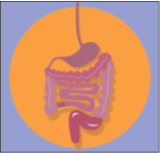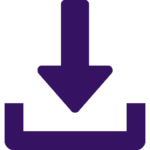Managing a high output stoma in IBD
Key points
- Stoma output can vary for a variety of reasons.
- If you have a high output stoma for more than 1-2 days seek advice from a doctor or Dietitian.
- A Dietitian can provide advice on what to eat and drink to modify your stoma output.

This dietary resource developed by DECCAN provides general dietary information on stomas in Inflammatory Bowel Disease (IBD).
The way your stoma behaves and your nutrition and hydration needs will depend on a where the stoma is located in the bowel, and the amount and types of food and drink consumed. This does not mean you should eat or drink less to reduce your stoma output. An IBD Dietitian can provide dietary recommendations to help manage your output, nutrition and hydration.
How much output should I expect from my stoma?
Ileostomy: ~600-1000ml/day of stool that is a toothpaste consistency.
Colostomy: ~300-400ml per day of thick semi-solid stool
Why is my stoma output much higher than a typical output?
Sometimes stomas output more than 1500-2000ml per day. This is called a high output stoma. The output is typically thin and watery and can increase after eating and drinking or first thing in the morning. A higher output can be common in the first few weeks after surgery and will usually thicken up and reduce as the remaining bowel adapts.
If prolonged, a high output stoma can lead to:
- Dehydration: dry mouth, dizziness, increased thirst, dark urine
- Unintentional weight loss and malnutrition
- Micronutrient deficiencies due to malabsorption
Other causes of a high output stoma include:

- Inflammation in the bowel above the stoma
- Swelling (oedema) in the bowel wall
- Gastrointestinal infections
- Small intestine bacterial overgrowth (SIBO)
- Bowel obstructions
- Fat / bile salt malabsorption due to previous surgery
- Medications
What can I do to reduce my stoma output to a usual volume?
- Separate your foods and fluids by ~1 hour
- Stay hydrated by drinking mostly oral rehydration solutions (see below)
- Eat 5-6 smaller, grazing-type meals across the day rather than large main meals
- Eat more salt to help replace the salt losses through the stoma
- Adding salt to meals in cooking and at the table
- Use stocks and sauces
- Include salted snacks such as corn chips, potato chips, crackers
- Eat more starchy carbohydrates to help thicken up the output
- Include grainy foods with meals e.g. rice, potato, pasta or noodles with meals
- Snack on crackers, toast, crumpets, English muffins, fruit buns
- Cheese and marshmallows can also thicken stoma output
- Limit insoluble fibre, e.g. nuts, seeds, fruit and vegetable skins, corn, celery
If your stoma output is high for more than 1-2 days, contact your doctor or Dietitian for advice. You may need medications to slow the passage of food through the gut (e.g. Gastrostop).
What are oral rehydration solutions (ORS)?
An oral rehydration solution is an isotonic fluid which has a similar salt and sugar concentration to our body. Our bowel can absorb this fluid better which helps you stay hydrated when you have a high output stoma.
Try to sip on oral rehydration solution throughout the day (away from meal times), and limit “other fluids” to 2-3 cups per day. “Other fluids” are all usual fluids Including water, mineral water, tea, coffee, soft drinks, juice, alcohol and milky drinks. You can purchase oral rehydration solutions from a pharmacy and make these up to a double strength or make your own at home (see recipe below).
Oral Rehydration Solution Recipes:
1. St Mark’s Solution
St Mark’s solution can be made at home. Mix the following ingredients into a jug and keep in the fridge to sip on during the day:
3.5g (1 level tsp) salt
2.5g (1⁄2 heaped tsp) sodium bicarbonate 20g (6 tsp) glucose
1L tap water
2. Double Strength Oral Rehydration Solution
2 x GastrolyteTM or HydrolyteTM tablets
200ml tap water
Buy oral rehydration tablets from the pharmacy (e.g. Gastrolyte or Hydrolyte. These must be used at a double strength to achieve the correct ratio of salt, sugar and water. Add 2 tablets to one glass of water or make a 1L jug by adding 10 tablets to 1L of tap water.

Acknowledgements:
This resource was developed in 2022 by the DECCAN Education materials working group that included the following Accredited Practicing Dietitians: Alice Day, Jessica Fitzpatrick, Emma Halmos, Katherine Healy, Liz Purcell, Emily Hunt, Rumbidzai Mutsekwa, Nadia Shadid, Clara Newsome, Sarah Phillips, Emma Landorf. Requests and enquires about this document should be directed to [email protected] or website www.deccanibd.org. DECCAN does not take any liability for any injury, loss or damage incurred by the use or reliance on this information.
Developed December 2022. Date for review December 2024.
